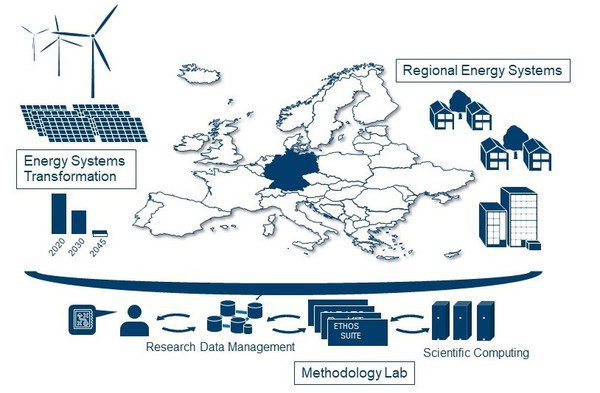8 July 2025
The direct capture of CO2 from ambient air is considered a key future technology for climate protection. However, a new study shows that weather conditions and choice of location have a major impact on efficiency and costs. For the first time, researchers from Jülich have calculated where such systems would be viable in Germany - and where they wouldn't.
Each citizen in Germany is currently responsible for an average of around ten tonnes of CO₂ emissions per year. That is roughly equivalent to the emissions from four round-trip transatlantic flights between Frankfurt and New York or the amount of CO₂ absorbed by 500 trees over a year. In view of Germany's ambitious climate targets, which aim to achieve greenhouse gas neutrality by 2045, there is a growing focus on new technologies that actively remove CO₂ from the atmosphere. One of these technologies is direct air capture (DAC).
Forschungszentrum Jülich is currently researching DAC - from materials and components to systems and their integration into energy infrastructure and climate protection strategies. Scientists at Jülich have now conducted the first comprehensive study of how weather and location influence the economic viability and energy consumption of such DAC systems. The results show that local conditions have a significant impact on efficiency and costs in some cases, meaning that a blanket rollout of DAC across the country would make little economic sense.
All methods are highly energy-intensive
DAC systems draw in large volumes of air, extract CO₂, and ensure its long-term storage - for example, in underground storage sites. "Two technologies are considered particularly promising," explains lead author Henrik Wenzel from Jülich Systems Analysis: "One is the solid sorbent-based adsorption process (LT-DAC), which requires comparatively low temperatures of around 110 °C to regenerate the filter materials, and the other is the liquid solution-based absorption process (HT-DAC), which requires higher temperatures of around 900 °C." However, both methods are energy-intensive, which is why their integration into a renewable energy system must be carefully planned."
In their study, the researchers calculated how temperature, humidity, and the potential for wind and solar energy influence the performance and cost of DAC systems for all 11,000 German municipalities. They used a high-resolution model that simulates, on an hourly basis, the interaction between weather, the renewable energy supply, and DAC system operation There was a focus on stand-alone systems, which operate completely independently of the power grid using locally generated wind or solar power.

Between € 200 and € 1000 per tonne
The results reveal striking differences: the energy demand of DAC systems in Germany can fluctuate over the course of the year by more than 100 %, primarily due to temperature variations and differing humidity levels. "Even within a single day, the energy demand of DAC systems can vary by up to 80 %," says Wenzel. "Particularly high humidity significantly increases the energy consumption of LT-DAC systems, whereas HT-DAC systems benefit from it." The potential for wind and solar energy also plays a pivotal role, as such energy can be used to supply the plants cost-effectively.
The most economically viable sites are located in northern Germany, where wind energy is particularly abundant. "However, low costs can also be achieved in other regions of Germany with good solar and wind energy locations, as a combination of these energy sources can efficiently cover the fluctuating energy requirements of DAC systems," explains Wenzel.
Depending on the location and technology, CO₂ removal costs in 2045 could vary between just under € 200 and over € 1,000 per tonne. "Which of the two DAC methods is more cost-effective depends on the region's specific location and weather conditions," explains co-author Thomas Schöb. "Both methods should therefore continue to be developed to ensure that sufficient capacity is available."
Not a free pass to continue emitting CO₂
The researchers stress that DAC can be a valuable lever for climate protection - but only when deployed in regions where weather and energy conditions complement each other optimally "Our study shows that location is crucial if we want to remove CO₂ efficiently from the air," explains Schöb. "It is essential to analyse regional weather conditions and energy potential in detail to ensure cost-effective and sensible use."
Even if technologies such as DAC alone will not be enough to neutralize Germany's current carbon footprint (around 10 t per capita), they can - when used strategically - help offset unavoidable residual emissions. However, the study also makes it clear that such solutions are not a free pass to continue emitting CO2. They require a great deal of energy, are costly, and must be carefully planned. Measures to avoid emissions remain the most important lever for effective climate protection.
Original publication: Weather conditions severely impact optimal direct air capture siting, by Henrik Wenzel, Freia Harzendorf, Kenneth Okosun, Thomas Schöb, Jann Michael Weinand, Detlef Stolten, Advances in Applied Energy
DOI: https://doi.org/10.1016/j.adapen.2025.100229







